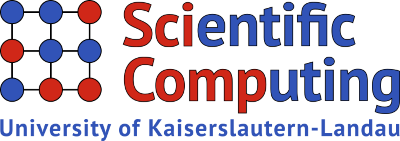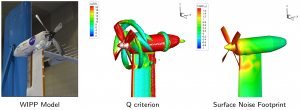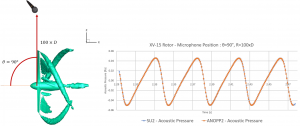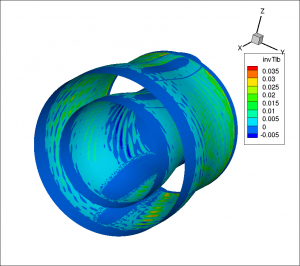Contact: Dr. -Ing. Beckett Y. Zhou, Prof. Dr. Nicolas R. Gauger.
Simulation and Optimization of a Wing-Tip Mounted Propeller Configuration
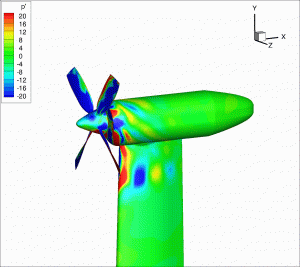 Propeller-driven engines have garnered renewed interest in the aircraft industry due to the emergence of unmanned aerial systems (UAS) and urban air mobility (UAM) systems. These engines have been shown to attain higher fuel efficiency over conventional turbofan engines. Wing-tip mounted propellers further increase the aerodynamic efficiency of the aircraft by attenuating the wing-tip vortices by the propeller slipstream. A major drawback with propeller-driven engines is their noise level. Particularly significant are the propeller-wing or propeller-fuselage interaction noise whereby the turbulent wake and tip vortices from the propeller blades impinge on the wing and the pylon leading to strong surface pressure fluctuation. In this project, we apply the unsteady RANS solver in SU2 with a multi-zone sliding mesh technique to simulate the turbulent flow field around wing-tip mounted propeller configuration released by the AIAA Workshop for Integrated Propeller Prediction (WIPP). The SU2 prediction agrees well with experimental data released by WIPP. Furthermore, the dominant noise source is identified at the wing leading edge immediately below the nacelle. On-going effort includes farfield noise prediction using the solid surface FWH approach and shape optimization of blade and wing leading edge to minimize interaction noise.
Propeller-driven engines have garnered renewed interest in the aircraft industry due to the emergence of unmanned aerial systems (UAS) and urban air mobility (UAM) systems. These engines have been shown to attain higher fuel efficiency over conventional turbofan engines. Wing-tip mounted propellers further increase the aerodynamic efficiency of the aircraft by attenuating the wing-tip vortices by the propeller slipstream. A major drawback with propeller-driven engines is their noise level. Particularly significant are the propeller-wing or propeller-fuselage interaction noise whereby the turbulent wake and tip vortices from the propeller blades impinge on the wing and the pylon leading to strong surface pressure fluctuation. In this project, we apply the unsteady RANS solver in SU2 with a multi-zone sliding mesh technique to simulate the turbulent flow field around wing-tip mounted propeller configuration released by the AIAA Workshop for Integrated Propeller Prediction (WIPP). The SU2 prediction agrees well with experimental data released by WIPP. Furthermore, the dominant noise source is identified at the wing leading edge immediately below the nacelle. On-going effort includes farfield noise prediction using the solid surface FWH approach and shape optimization of blade and wing leading edge to minimize interaction noise.
Project Partners: Myles Morelli and Alberto Guardone (Politecnico di Milano)
Related Publications:
- B.Y. Zhou, N. R. Gauger, M. Morelli, A. Guardone, “Simulation and Design Optimization of a Wing-Tip Mounted Propeller Configuration from the Workshop for Integrated Propeller Prediction (WIPP)”, AIAA AVIATION 2020 Forum, Reno, NV, 2020. (Submitted)
In-Flight Ice Detection via Computational Aeroacoustics and Bayesian Neural Networks
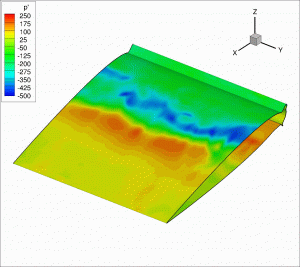 Reliable real-time detection of ice formation is a critical enabling technology in improving rotorcraft safety. In this work, we demonstrate the proof-of-concept development of a real-time in-flight ice detection system using computational aeroacoustics and Bayesian neural networks. A finite NACA0012 airfoil section undergoing sinusoidal pitching is used to represent the cyclic motion characteristic of a rotor in forward flight. Experimental ice shape measurements from the NASA Glenn Icing Research Wind Tunnel are used for validation of the numerical ice shapes. The flow-fields of the computed ice shapes are then determined using a hybrid RANS/LES approach and the acoustic noise signals of the ice shapes are predicted using the solid-surface Ffowcs Williams and Hawkings (FWH) analogy. A Bayesian neural network is then trained using the ice shapes and the performance indicators are mapped to the acoustic noise signals. This framework thus allows for the detection of ice and significantly the type of ice accreted over the pitching wing through differentiating between iced noise signals. The corresponding aerodynamic coefficients of the ice airfoil as well their uncertainties can be predicted in real time. Overall, this information can be extremely useful for pilot decision-making in assessing the icing condition as well as the extent of uncertainty of the prediction.
Reliable real-time detection of ice formation is a critical enabling technology in improving rotorcraft safety. In this work, we demonstrate the proof-of-concept development of a real-time in-flight ice detection system using computational aeroacoustics and Bayesian neural networks. A finite NACA0012 airfoil section undergoing sinusoidal pitching is used to represent the cyclic motion characteristic of a rotor in forward flight. Experimental ice shape measurements from the NASA Glenn Icing Research Wind Tunnel are used for validation of the numerical ice shapes. The flow-fields of the computed ice shapes are then determined using a hybrid RANS/LES approach and the acoustic noise signals of the ice shapes are predicted using the solid-surface Ffowcs Williams and Hawkings (FWH) analogy. A Bayesian neural network is then trained using the ice shapes and the performance indicators are mapped to the acoustic noise signals. This framework thus allows for the detection of ice and significantly the type of ice accreted over the pitching wing through differentiating between iced noise signals. The corresponding aerodynamic coefficients of the ice airfoil as well their uncertainties can be predicted in real time. Overall, this information can be extremely useful for pilot decision-making in assessing the icing condition as well as the extent of uncertainty of the prediction.
Project Partners: Myles Morelli and Alberto Guardone (Politecnico di Milano)
Jeremiah Hauth and Xun Huan (University of Michigan)
Related Publications:
- B.Y. Zhou, N. R. Gauger, M. Morelli, A. Guardone, J. Hauth, X. Huan, “Development of a Real-Time In-Flight Ice Detection System via Computational Aeroacoustics and Bayesian Neural Networks”,AIAA-2019-1638, AIAA SciTech Forum, Orlando, Florida, January 2020.
Rotor/Propeller Noise Prediction and Minimization
This NASA-funded effort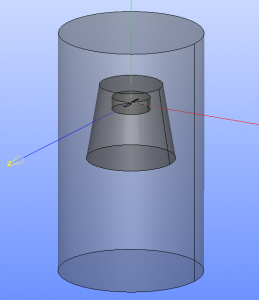 focuses on the development of an integrated aeroacoustic optimization framework to enable efficient noise-reducing designs of propeller and rotor blades, in support of the NASA Transformational Tools and Technologies (TTT) Program. This project builds on the existing development of the fixed-body Ffowcs Williams-Hawkings solver and the coupled CFD-FWH adjoint in SU2 (see Past Projects below). In particular, the current FWH implementation in the ‘wind-tunnel formulation’ is extended to Farassat’s full F1A form to account for moving sources. The coupled adjoint solver will also be modified to enable sensitivity computations on rotating/sliding meshes. In addition to isolated propellers/rotors, prop-prop and prop-wing interaction noise will also be investigated. The target configuration is the NASA X57 Maxwell distributed propulsion aircraft.
focuses on the development of an integrated aeroacoustic optimization framework to enable efficient noise-reducing designs of propeller and rotor blades, in support of the NASA Transformational Tools and Technologies (TTT) Program. This project builds on the existing development of the fixed-body Ffowcs Williams-Hawkings solver and the coupled CFD-FWH adjoint in SU2 (see Past Projects below). In particular, the current FWH implementation in the ‘wind-tunnel formulation’ is extended to Farassat’s full F1A form to account for moving sources. The coupled adjoint solver will also be modified to enable sensitivity computations on rotating/sliding meshes. In addition to isolated propellers/rotors, prop-prop and prop-wing interaction noise will also be investigated. The target configuration is the NASA X57 Maxwell distributed propulsion aircraft.
Project Partners: Leonard V. Lopes (NASA Langley Research Center)
Omur Icke, Andy Moy and Oktay Baysal (Old Dominion University)
Boris Diskin (National Institute of Aerospace)
Funding Source: NASA Transformational Tools and Technologies (TTT) Program
Validation Campaign for the SU2 Aeroacoustic Solver
A range of aeroacoustic benc hmark cases are scheduled to be examined to validate the noise prediction capabilities of the SU2 aeroacoustic solver. The turbulent flow field is resolved with the DDES solver with a new shear-layer adapted (SLA) subgrid scale model and the modified simple low dissipation AUSM (SLAU2) flux scheme. The acoustic propagation is performed with the solid/permeable-surface FWH solver. The hybrid DDES-FWH framework has been applied to the first validation case of the tandem cylinder. Turbulent flow quantities as well as far-field noise levels are compared against measurements obtained at NASA facilities. Other planned validation cases include: 30P30N three-element high-lift configuration, single-stream round jet, and rudimentary landing gear.
hmark cases are scheduled to be examined to validate the noise prediction capabilities of the SU2 aeroacoustic solver. The turbulent flow field is resolved with the DDES solver with a new shear-layer adapted (SLA) subgrid scale model and the modified simple low dissipation AUSM (SLAU2) flux scheme. The acoustic propagation is performed with the solid/permeable-surface FWH solver. The hybrid DDES-FWH framework has been applied to the first validation case of the tandem cylinder. Turbulent flow quantities as well as far-field noise levels are compared against measurements obtained at NASA facilities. Other planned validation cases include: 30P30N three-element high-lift configuration, single-stream round jet, and rudimentary landing gear. 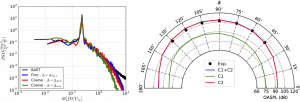
Project Partners: Eduardo E. Molina and Juan J. Alonso (Stanford University)
Related Publications:
- E.S. Molina, B.Y. Zhou, J.J. Alonso, M. Righi, R. G. Silva, “Flow and Noise Predictions Around Tandem Cylinders using DDES Approach with SU2”, AIAA-2019- 0326, AIAA SciTech Forum, San Diego, California, January 2019.
Adjoint-based Broadband Noise Minimization using Stochastic Noise Generation
The conventional approach to predict broadband noise (BBN) is to first resolve the near-field turbulent flow with a scale-resolving method such as LBM, LES or hybrid RANS/LES. The noise source is then propagated to the far-field using an acoustic analogy such as FWH. This two-stage approach is well-established in the aeroacoustic community. However, when an adjoint-based method is developed for such framework for optimal design purposes, the chaotic nature of the underlying turbulent flow causes the adjoint solution to diverge — an active research topic investigated by several groups. 
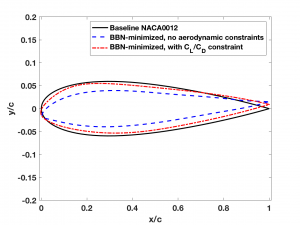 In this work, we develop an efficient framework based on stochastic noise generation (SNG), whereby the BBN source is stochastically synthesized using the mean flow turbulent quantities extracted from a preceding RANS solution. In addition to accessing BBN source characteristics and providing reliable design trends at a significantly reduced computational cost, this method also circumvents the divergence issue plaguing the adjoint solutions for scale-resolving simulations. This framework has been implemented in the SU2 solver suite, with coupled RANS-SNG adjoint to enable design optimization. Efforts to verify the reliability of this method using LES+FWH are currently underway.
In this work, we develop an efficient framework based on stochastic noise generation (SNG), whereby the BBN source is stochastically synthesized using the mean flow turbulent quantities extracted from a preceding RANS solution. In addition to accessing BBN source characteristics and providing reliable design trends at a significantly reduced computational cost, this method also circumvents the divergence issue plaguing the adjoint solutions for scale-resolving simulations. This framework has been implemented in the SU2 solver suite, with coupled RANS-SNG adjoint to enable design optimization. Efforts to verify the reliability of this method using LES+FWH are currently underway. 
Project Partners: Hua-Dong Yao, Shia-Hui Peng and Lars Davidson (Chalmers University of Technology)
Related Publications:
- B.Y. Zhou, N.R. Gauger, H-D. Yao, S-H. Peng, L. Davidson, “Towards Adjoint-based Broadband Noise Minimization using Stochastic Noise Generation”, AIAA-2019- 0002, AIAA SciTech Forum, San Diego, California, January 2019.
Numerical Optimization of Porous Surfaces for Trailing-Edge Noise Reduction (Phase II: Broadband Noise)
In this project, we continue our earlier effort (see Past Projects below) in developing an adjoint-based framework for the optimal design of porous aerodynamic surfaces to reduce trailing-edge noise, which is a dominant airframe noise source on an aircraft flying in the ‘clean’ configuration with all high-lift devices and landing gear stowed. The focus of the current work is on broadband noise. To that end, porous material is applied to an airfoil section with a sharp trailing edge. In addition, a poro-serrated trailing edge design is also investigated. Both aerodynamic and aeroacoustic performances of the designs are evaluated at two operating conditions: the low-Mach number takeoff/landing condition and the transonic cruise condition.
Project Partners: Sutharsan Satcunanathan, Matthias Meinke and Wolfgang Schröder (Aachen Institute of Aerodynamics)
Funding Source: German Research Foundation (DFG)
Past Projects
Development of Aeroacoustic Prediction and Optimization Capabilities in SU2
A permeable surface Ffowcs Williams-Hawkings (FW-H) acoustic solver is implemented in the open-source multi-physics solver SU2. The FWH solver is coupled with the existing URANS and DDES solvers in SU2 for aeroacoustic acoustic predictions at arbitrary far-field observer locations. In addition, a consistent and robust discrete adjoint solver is developed on the basis of algorithmic differentiation (AD), to enable efficient aero-acoustic design sensitivity evaluation of the coupled CFD-FWH system.
This coupled simulation and design framework is applied to the shape optimization of an airfoil section of a rod-airfoil configuration, to minimize the interaction noise. The optimization is conducted on the basis of URANS-FWH while the aeroacoustic analysis of the baseline and optimized designs are performed using the high fidelity DDES-FWH solver. 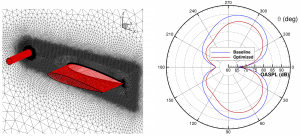
Project Partners: Carlos R. Ilário da Silva (Embraer S. A.)
Thomas Economon and Juan J. Alonso (Stanford University)
Funding Source: Natural Science and Engineering Research Council Postgraduate Scholarship (NSERC-PGS-D)
Related Publications:
- B.Y. Zhou, T.A. Albring, N.R. Gauger, C.R. Ilario da Silva, T.D. Economon, and J.J. Alonso, “Reduction of Airframe Noise Components Using a Discrete Adjoint Approach”, AIAA-2017- 3658, 18th AIAA/ISSMO Multidisciplinary Analysis and Optimization Conference, Denver, Colorado, June 2017.
- B.Y. Zhou, T.A. Albring, N.R. Gauger, C.R. Ilario da Silva, T.D. Economon, and J.J. Alonso, “A Discrete Adjoint Approach for Jet-Flap Interaction Noise Reduction”, AIAA 2017-0130, 58th AIAA/ASCE/AHS/ASC Structures, Structural Dynamics, and Materials Conference, Grapevine, TX, January 2017.
- B.Y. Zhou, T.A. Albring, N.R. Gauger, T.D. Economon, F. Palacios, and J.J. Alonso, “A Discrete Adjoint Framework for Unsteady Aerodynamic and Aeroacoustic Optimization”, AIAA-2015-3355, 16th AIAA/ISSMO Multidisciplinary Analysis and Optimization Conference, Dallas, TX, June 2015. (Best Paper Award)
Numerical Optimization of Porous Surfaces for Trailing-Edge Noise Reduction (Phase I: Tonal Noise)
In order to meet the stringent noise emission requirement imposed by various regulatory bodies, it is insufficient to simply reduce the noise components related to undercarriages and high-lift devices — the noise from the ‘clean’ aircraft flying at constant altitude with all high-lift devices and landing gear stowed, must also be reduced. In this work, we focus on the minimization of trailing-edge noise — a dominant airframe noise mechanism on an aircraft flying in the clean configuration, generated due to the scattering of energy in turbulent eddies in the boundary layer as they convect across a trailing edge. To that end, porous material is applied to a flat plate with a blunt trailing edge, which exhibits a pronounced tonal noise component associated with periodic vortex shedding due to the bluntness of the trailing edge.
Adjoint-based noise minimization is performed to determine the optimal distribution of the design variables that govern the porosity and permeability of the trailing edge material. The optimal design obtained is found to attain a maximum noise reduction in OASPL of 12dB from the solid trailing edge and 3dB from the baseline design with a linear porosity variation respectively. The design space of this optimization problem is also found to be multi-modal.
Project Partners: Seong R. Koh, Matthias Meinke and Wolfgang Schröder (Aachen Institute of Aerodynamics)
Funding Source: German Research Foundation (DFG)
Related Publications:
- B.Y. Zhou, N. R. Gauger, S. Koh, M. Meinke, and W. Schröder “A Discrete Adjoint Framework for Trailing-Edge Noise Minimization via Porous Material”, Computers and Fluids, Vol. 172, pp. 97-108, May 2018
- S. Koh, B.Y. Zhou, M. Meinke, N. R. Gauger, and W. Schröder “Numerical Analysis of the Impact of Variable Porosity on Trailing-Edge Noise”, Computers and Fluids, Vol. 167, pp. 66-81, June 2018
Efficient Optimization of Acoustic Liners for Engine Noise Reduction
Due to the exposed radiation from an aircraft flying over urban areas, the air-traffic noise affects a large number of people and became a significant environmental problem. The situation became more severe due to the rapid increase of air-traffic in recent years. In fact, the growth of an airport is found to be limited mainly by the public acceptance of the air traffic with respect to the noise emission. Due to the effects of noise on environment and health, aircraft noise reduction has been an important objective of the national and European research activities.
As far as the noise emission is concerned, the noise generated by the turbofan aero-engines is still the major source of noise at landing and take-off. Therefore, reducing engine noise is one of the important goals in the turbofan engine design. Today, the passive treatment using acoustic liners in aero-engines is a standard technique. The best ratio of weight and noise reduction is currently achieved by generalized Helmholtz resonator panels. The third generation of such panels consist of a rigid back plate, cavities and a perforated face sheet. With the development of optimized CAA methods and impedance modelling, it has become possible to simulate the effect of these acoustic liners on the sound level for a given acoustic source.
In this project we aim at developing an efficient optimization framework for the numerical optimization of acoustic liner parameters. These kind of optimization problems are characterized by the large number of design parameters as well as the high numerical cost of CAA simulations caused by the unsteadiness of the sound propagation phenomena. Combining adjoint technology with the advanced gradient-based numerical optimization methods, it is possible to find the optimum distribution of liner parameters that gives the best acoustic performance for a given engine design.
Partners: CFD GmbH Berlin
Funded by BMWi LuFo (Luftfahrtforschungsprogramm)
Contact: Dr. Emre Özkaya, Prof Nicolas R. Gauger.
